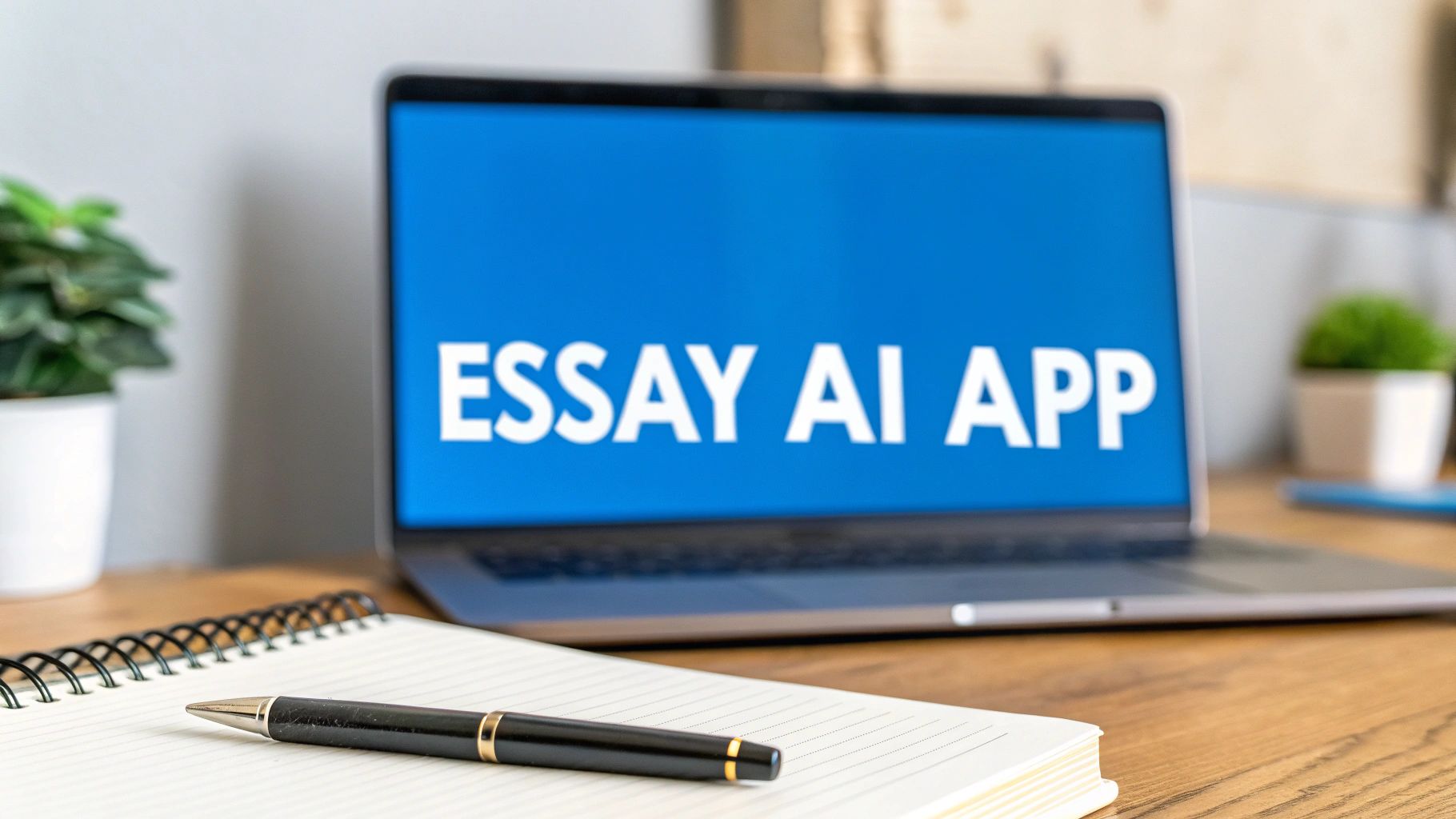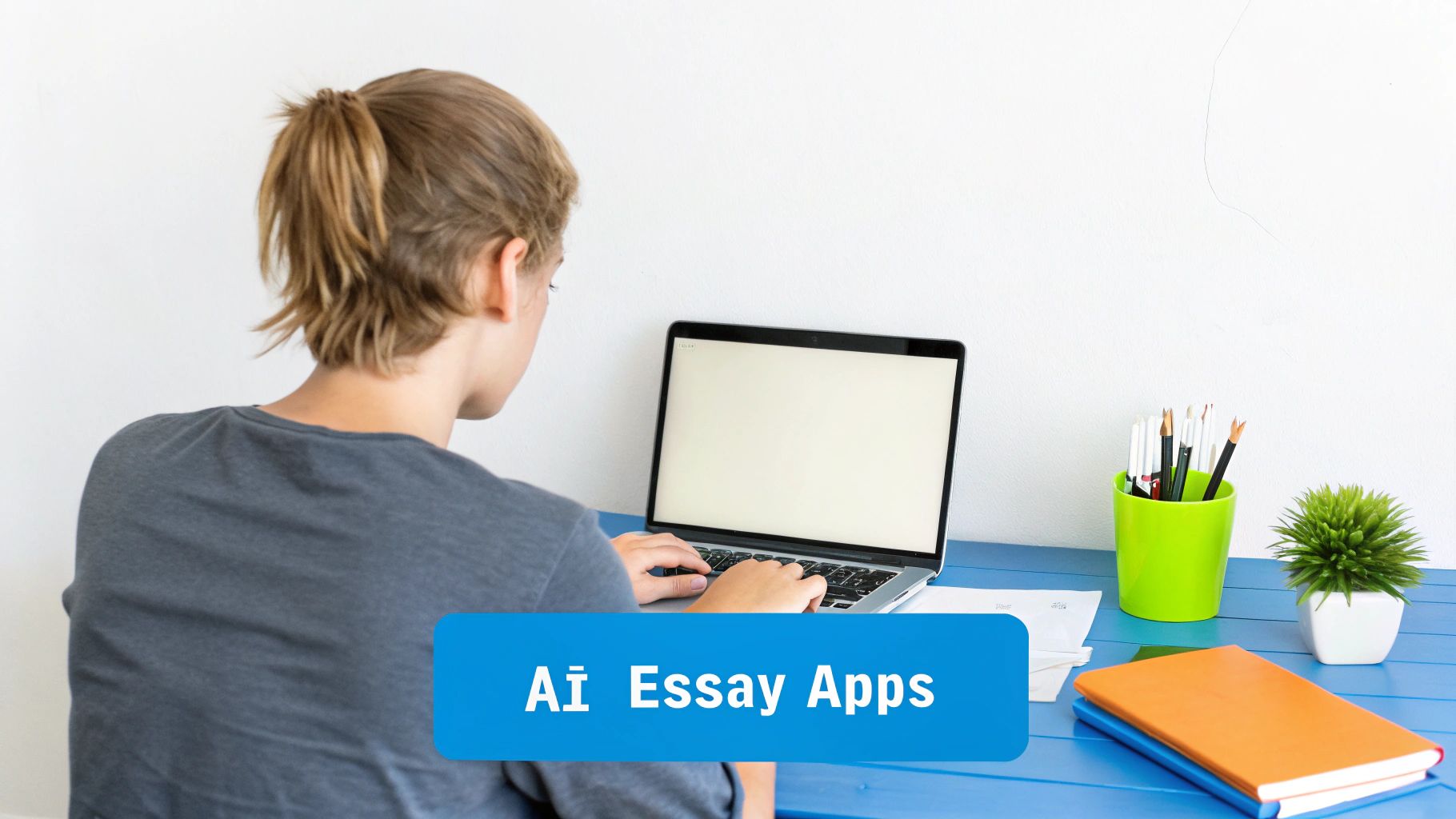What Is the AI App Everyone Is Using to Write Essays?

If you’re wondering, “What is the AI app everyone is using to write essays?” you’ll find the answer isn’t a single, magic-bullet tool. Instead, a whole family of writing assistants has swept through college campuses, becoming the new go-to for students. We’ve moved way beyond basic spell-checkers into the era of true writing partners.
The Rise of AI Assistants in Academic Writing

The days of students leaning on dusty grammar guides and a thesaurus are pretty much over. Today’s academic world is powered by a new kind of support system: writing tools. These aren’t just for catching typos anymore; they’re involved in every single stage of the writing process. For a bird’s-eye view of how these tools work, check out a comprehensive AI-powered writing assistant guide.
This shift isn’t just a feeling—the data backs it up. The demand for essay writing tools absolutely exploded, with global searches jumping by a staggering 537% between January 2023 and January 2024. During that same period, searches for old-school paid essay services actually dropped by 41%. This shows a massive change in how students are getting their assignments done.
AI is becoming essential for a few key reasons:
- Beating Writer’s Block: It can help brainstorm topics, structure thoughts, and even create a full outline to get you started.
- Drafting on Demand: Need to get some words on the page? These tools can produce initial drafts to help you break through the blank-page paralysis.
- Supercharged Research: Many apps can summarize lengthy articles and pull out relevant information in seconds, saving you hours of work.
The rapid acceptance of these writing assistants is a huge moment in education. To get a closer look at the specific tools leading the charge, you should read our guide on the http://word-spinner.com/blog/what-is-the-ai-app-everyone-is-using-to-write-essays/.
Core Functions of Popular Essay Writers
To give you a clearer picture, most of these essay-writing apps are built around a few common, powerful functions. They’re designed to tackle the most time-consuming and difficult parts of academic writing, making the whole process feel much more manageable.
| Function | What It Does | Benefit for Essay Writing |
|---|---|---|
| Topic Brainstorming | Suggests a list of possible essay topics based on your subject or keywords. | Instantly gives you creative ideas when you’re feeling stuck. |
| Outline Creation | Structures your essay with a logical flow, including introduction, body paragraphs, and conclusion. | Gives you a solid roadmap to follow, making sure your arguments are well-organized. |
| Content Creation | Writes paragraphs or full sections of your essay based on specific prompts and instructions. | Helps overcome writer’s block by producing a first draft you can then edit and make your own. |
| Paraphrasing | Rewrites sentences or passages to avoid plagiarism while keeping the original meaning. | Makes sure your work is original and helps you include sources smoothly. |
| Citation Formatting | Automatically formats your sources into styles like APA, MLA, or Chicago. | Saves a ton of time and prevents formatting mistakes in your bibliography. |
| Grammar & Style Check | Corrects spelling, grammar, and punctuation while suggesting improvements for clarity and tone. | Polishes your final draft to a professional standard, improving your overall grade. |
These core functions work together to act as a co-pilot for your writing, letting you focus more on your ideas and less on the tedious mechanics.
How Essay Writing Apps Actually Work

Ever wondered what’s going on behind the screen when an app writes an essay? It’s not magic, but it’s pretty close. Think of it less like a thinking, feeling writer and more like a super-powered research assistant who has devoured nearly every book, article, and website ever published.
These tools aren’t “thinking” in the way we do. They’re incredibly good pattern matchers. When you give an app an essay prompt, it doesn’t creatively ponder your request. Instead, it dives into its colossal database of text to find patterns connected to your topic.
It’s a bit like the predictive text on your phone, just on an unimaginable scale. It calculates the most probable word to come after the last one, piecing together sentences and paragraphs based on pure statistical likelihood. This is why the quality of your instructions—your prompts—is everything. A fuzzy prompt leads to a general, unfocused essay, while a detailed one gives the program a clear roadmap to follow.
From Prompt to Paragraph
The engine running these apps is a large language model (LLM). This is the “brain” that has been fed mountains of human writing. When it gets your prompt, it breaks it down and kicks off that word-prediction process.
Here’s a simplified look at how it all happens:
- Instruction Analysis: First, the program figures out your prompt to understand the subject, the tone you’re after, and the required structure.
- Information Retrieval: Next, it scans its training data for relevant ideas, facts, and sentence structures related to your topic.
- Text Construction: Finally, it starts building the essay one word at a time, always picking the next word that is statistically most likely to appear in that specific context.
It’s very important to remember that these tools aren’t doing live research. They are reconstructing information from the data they were trained on, which can sometimes be old or wrong. This is exactly why a human touch—your oversight and fact-checking—is still a vital part of the process.
Exploring the Most Popular Essay Writing Tools
When you’re trying to figure out what app everyone is using to write essays, you won’t find a single answer. Instead, the scene is dominated by a handful of really powerful options, each with its own special strengths.
The leader of the pack is definitely OpenAI’s ChatGPT, which commands a massive 28% of the market. Hot on its heels are competitors like Anthropic’s Claude with a 17% share and Microsoft’s Copilot Pro, which has carved out 14% for itself. Even newer, more specialized tools like WriteMind have quickly snatched up an 8% share by homing in on what specific users really need.
This chart breaks down some key numbers on how students are using these tools, how much faster they’re writing, and how happy they are with the results.

The data speaks for itself. It’s obvious that a huge number of students are using these apps and seeing real, tangible benefits in their writing speed—and they’re generally thrilled with the outcome.
Choosing the Right Tool for the Job
While the big players like ChatGPT are fantastic all-rounders, the best tool for you often comes down to the specific assignment you’re working on. Some tools are brilliant for banging out a quick first draft, while others are better suited for deep research or getting your citations just right. For example, a student tackling a complex research paper would probably want a tool that’s great at finding and citing sources.
The real secret is to think of these apps not as a one-size-fits-all solution, but as a complete toolbox. Different essays and writing styles simply call for different tools to get the job done right.
If you want to get a better handle on the top writing applications out there, it’s worth checking out this comprehensive guide to popular AI models like ChatGPT, Gemini, Perplexity, and Claude.
Once you’ve used one of these tools to get a draft down, the crucial final step is to make the text truly yours. For that final polish, Word Spinner is an amazing choice. It is designed to rewrite text so it sounds completely natural, making sure your final essay has that essential human touch and is 100% plagiarism-free.
Using AI as a Partner for Better Writing

Here’s a good approach: think of an essay writing app as a creative sidekick, not just a content producer. Instead of commanding it to write an entire essay from scratch, use it to smash through writer’s block or find fresh angles on a topic you’re stuck on.
Treat it like a brainstorming buddy. It can suggest ideas, help you structure a killer outline, or simplify dense subjects you’re struggling to put into words. This method makes sure you stay in control, using the tool to sharpen your own critical thinking instead of letting it do the work for you. To learn more about this important part of the process, check out our guide on how to humanize AI text.
One thing you absolutely cannot skip is to verify every fact the tool gives you. These models can occasionally “hallucinate” and present wrong information as gospel. Always double-check data against trusted academic sources and make sure every citation is formatted perfectly according to your school’s guidelines.
Making the Final Draft Your Own
Once the program has helped you build a draft, it’s time to make it sound like you. This is where you inject your own personality, analysis, and a natural rhythm that matches your writing style.
- Rewrite for Clarity: Comb through every sentence, rephrasing it in your own words.
- Add Personal Insight: Weave in your own arguments and opinions to give the essay a genuine perspective.
- Check for Tone: Make sure the writing style fits the assignment and sounds like an actual person wrote it.
By actively working with the machine’s output—challenging it, editing it, and personalizing it—you elevate a simple machine-written text into a polished piece that is genuinely your own.
For this final, all-important stage, a specialized tool like Word Spinner is a great help. Its powerful rewriting engine is built specifically to humanize content, smoothing it out with a natural tone that avoids detection. This is how you make sure your submission is polished, authentic, and 100% plagiarism-free.
Navigating the Risks and Ethical Questions
While essay writers are incredibly helpful, it’s smart to know the risks and walk the ethical lines carefully. For students, the biggest thing to watch out for is academic integrity. Most schools have a zero-tolerance policy for submitting an essay written entirely by a program, often treating it just like plagiarism.
As these tools have popped up everywhere, schools are playing catch-up. They’re updating their policies and rolling out detection software that scans for the tell-tale signs of machine-written text. This creates a high-stakes environment where you need to be smart about how you use these aids.
It’s a huge, growing conversation. The essay generator market is expected to hit around $250 million in 2025 and is projected to grow by 25% annually through 2033. But even with this boom, the debates around ethics and plagiarism are still shaping the rules.
Common Weaknesses and How to Handle Them
It’s also very important to remember that these tools aren’t magic—they have some real weak spots you need to manage.
- Inaccurate Information: A program can sometimes make things up, known as “hallucinations,” and present them as solid facts. You absolutely must fact-check everything it gives you against reliable sources.
- Hidden Biases: These tools learn from the internet, which means they can accidentally pick up and repeat societal biases in their writing without you even realizing it.
- Lack of Original Thought: A program is fantastic at summarizing what’s already out there. It’s not so great at creating truly original arguments or deep, critical thoughts.
The real question isn’t just if you use the technology, but how. The line between a powerful study aid and academic dishonesty can be pretty thin, and that’s why knowing your school’s specific policy is always the first step.
If you want to get deeper into this, check out our article that asks if using AI for essays is cheating. It offers a balanced look to help you figure out the best way forward.
Common Questions About Essay Writers
As writing tools find their way into every student’s toolkit, some real-world questions are bound to pop up. Let’s dig into a few of the big ones so you can use these tools the right way.
Can Teachers Tell If an Essay Was Written by an AI?
More and more, yes, they can. Most schools and universities have started using detection software that’s getting pretty good at spotting the classic signs of machine-written text. These programs aren’t foolproof, but they are getting smarter every day.
Just copying and pasting an entire essay from a program is a huge gamble. The better approach is to use it as your brainstorming partner or to get a first draft on paper. You still need to do the real writing yourself. If you’re worried about your text sounding a bit robotic, it’s a good idea to learn how to make your essay not AI detectable to smooth out the edges.
Is Using an App for My Essay Cheating?
This is the million-dollar question, and the answer really boils down to your school’s specific academic honesty policy. Submitting an essay written completely by a program is almost always considered plagiarism. But using it for outlining, checking your grammar, or just bouncing ideas around? That’s usually fine.
The bottom line is to always check your school’s official rules first. The goal should be to use these apps to help you learn, not to have them do all the heavy lifting for you.
What Are the Biggest Drawbacks of Using These Tools?
These writers definitely have some blind spots. One of the biggest issues is that they can sometimes present totally wrong or outdated information as stone-cold fact—a problem people in the know call “hallucinations.” They also aren’t great at coming up with truly original arguments or digging deep with critical analysis, since they’re just remixing data they’ve already been fed.
Finally, the writing can feel a little… soulless. It often lacks the personal voice and unique perspective that makes an essay truly shine. Always, always double-check the facts and make sure you’re weaving your own thoughts and personality into any text a program helps you create.
To make sure your final essay sounds authentic and is 100% original, give Word Spinner a try. Its powerful rewriting and humanizing features are perfect for refining those machine-assisted drafts into polished, plagiarism-free work that actually sounds like you.